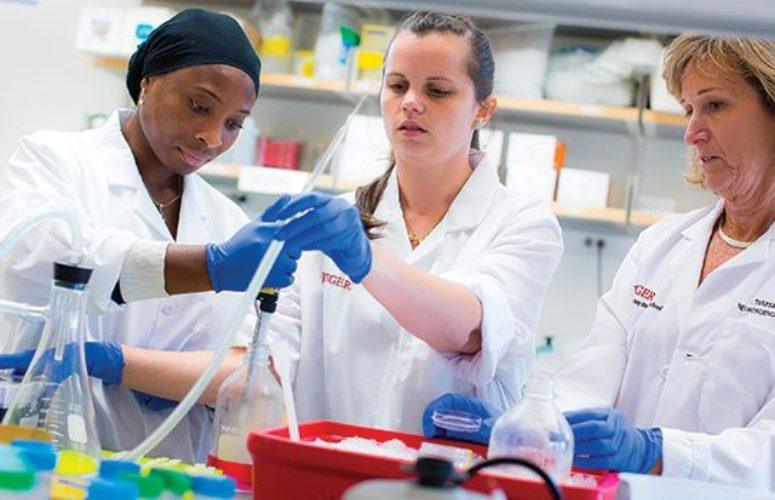
Higher Education’s Innovation Renaissance
The state’s research universities and other institutions of higher education are becoming the pied pipers of innovation, attracting businesses for a variety of high-tech collaborations.
By Anthony Birritteri, Editor-in-Chief On May 27, 2015New Jersey is in the midst of an innovation renaissance, but unlike its past history of high-tech discoveries, which largely emerged from the R&D labs of large corporations (think: Bells Labs, RCA and its David Sarnoff Research Center, and host of large pharmaceutical companies), innovations today are coming from the teaming of higher education and business. And though academic/business partnerships are not new, what is new is the synchronized movement that all entities – the state, institutions of higher education and businesses – are marching in, with the common goal of growing New Jersey’s reputation as the “Innovative State.”
The Corporate R&D Changeover
Explaining what happened to the old corporate research model, Dr. Donald Sebastian, president of the New Jersey Innovation Institute (NJII) at the New Jersey Institute of Technology (NJIT), Newark, says the great inventor scientists/entrepreneurs of yesteryear (think: Thomas Edison), formed their own companies, which evolved into R&D being managed by corporate leadership. “The legacy was to pass on the inventiveness into a structured and well-organized entity called corporate R&D,” Sebastian says.
“All of that was dismantled in the 1980s in the spirit of rightsizing, downsizing and outsourcing,” he explains. “Today, there are not too many large entities with the comprehensive knowledge of an industry sector that have the freedom, time, intellect and full set of disciplinary backgrounds to focus on [big picture innovations],” he says.
On the other side of coin, Sebastian says the federal government began funding basic research at the university level after World War II, “but that model has been failing because while institutions of higher education can work on the innovations, they lack the knowledge of how to turn that technology into [practical] inventiveness because they lack the knowledge of the marketplaces.”
Adds Christopher J. Molloy, Ph.D., R.Ph., senior vice president for research and economic development at Rutgers University, “As mature industries in the state have adjusted their business models – including R&D – universities, if their eyes are wide open, have the ability to pick up some of these responsibilities and work with industry in a hand-in-glove relationship.”
Given the two preceding views, it is logical that business and academia should turn to each other for assistance, whether it is for technology transfer, sponsored research or workforce development initiatives.
According to Prof. Michael Palladino, Ph.D., dean of the School of Science at Monmouth University in Long Branch, “If you look at some of the major tech hubs across the country – e.g., Silicon Valley and biotech research corridors in Boston and North Carolina – those areas have been leveraging their academic institutions to attract companies with incentives to foster collaboration. New Jersey has never been systematic in doing that, but at many levels, these conversations are now happening,” he says.
Spearheading these conversations, Palladino says, are organizations such as: The New Jersey Council on Innovation; Innovation New Jersey; Einstein’s Alley; The NJ Stem Pathways Network, established by Office of the Secretary of Higher Education; BioNJ; the New Jersey Tech Council; and many others.
The following profiles offer a glimpse of how leading higher education institutions are answering the call for business collaboration and, in turn, are sparking innovation.
New Jersey Institute of Technology
Last year, NJIT debuted its New Jersey Innovation Institute (NJII), an organization that applies the intellectual and technological resources of NJIT to the challenges of industry partners. Through its Innovation Labs (iLabs), NJII brings NJIT expertise to key economic sectors, including healthcare delivery systems, biopharmaceutical products, civil infrastructure, defense and homeland security, and financial services.
According to Sebastian, “One of the purposes of the NJII is to get companies together to recognize, define and fund technology growth that they are going to need, and do it in a way that gets industry-wide platforms, but also propriety spin offs, and work in ways that are directed towards the commercial aspects of science and technology.”
He says that the NJII’s motto to businesses is: “How may we help you?”
“This is about looking at an industry issue that is too big for one company to deal with on its own because no one has the resources. So, we try to execute on the things individual companies can’t do on their own,” he says.
As an example of NJII’s work in healthcare delivery systems, the healthcare iLab is pulling together hospitals, physicians groups, service providers and rate payers to try to help decrease healthcare costs while increasing the quality of – and access to – care. “A lot of that revolves around using information technology in a more comprehensive way. So, we are running a regional health information exchange; a computer network in which physicians can connect to other healthcare players,” Sebastian explains.
He says that the NJII is not exclusive to NJIT and that the institute has been designated by the state’s Council on Innovation (see related story on page 34) to be a “front end to all state university assets,” says Sebastian.
“I say with certainty that no one university has the assets to serve the five industry sectors we are focused on. For example, Bell Labs at one time had 10,000 of the world’s best minds in the telecom industry. NJIT has a faculty of 350 … and Rutgers may have 1,200. You put that all together in a bucket and you still don’t equal what worked for one industry. So, this is destined to create a meeting place for the competencies at our universities.”
Asked if NJII is looking to be the next Bell Labs, Sebastian says, “That is our aspiration.”
Stevens Institute of Technology
At Hoboken-based Stevens Institute of Technology, Professor Werner Kuhr and his staff within the institute’s Office of Innovation and Entrepreneurship (OIE) are busy teaching engineering students that entrepreneurialism is a core value because “it is not only important to solve a problem or invent a technology, but that technology must have value and significance to potential customers. … It’s all about getting the engineer and scientist out of the cubicle and into the real world,” Kuhr says.
As director of technology commercialization with the (OIE), Kuhr leads the development and exploitation of Steven’s intellectual property portfolio. The OIE seeks to redefine the traditional university-industry technology transfer process via an open system in which partners with diverse backgrounds combine their expertise to create technological innovations that lead to successful tech transfer ventures.
“One key problem with most university tech transfer offices is that they act as gatekeepers, hoarding intellectual property and parsing it out as necessary,” Kuhr says. “At Stevens, we have an open door policy. We are trying to be more proactive in terms of giving people access to the latest research and making the process of licensing technology much friendlier and more rapid.
Kuhr says Stevens also streamlined the technology transfer process. “Most universities rely on a traditional licensing agreement that can be 20 pages of legalese, which most startups wouldn’t understand.
“What we have done for small startups is start with a one-page memorandum of understanding, saying that we will give the company the right to create an option agreement with the university for a technology. If the company were to get an angel investor who would be investing a few hundred thousand dollars, we would then want, at least, a three- to four-page option agreement that would outline the basic terms of the deal regarding royalty rates and access to investigators. When they get to series A round [of funding], raising $4 million to $5 million, then it is time to put a real licensing agreement in place.”
Based on its institute-wide strategic plan, the OIE is concentrating its efforts on: healthcare and medicine; sustainable energy; financial systems; defense and security; and STEM education.
One company emanating from Stevens is iubble, founded by electrical engineering and computer science major Kevin Baressi. iubble, which has raised more than $50,000 in funding, is a social web browser in which a user can easily organize and share content via dragging items onto a bubble, rather than keeping various browser tabs open. This information can open on someone else’s computer screen, so the principal user does not have to cut and paste information.
Rutgers University
The Corporate Engagement Team at Rutgers University has been busy pulling together faculty information at all three campuses (New Brunswick, Newark and Camden), and including it in a revised Business Portal (www.businessportal.rutgers.edu). The portal offers access to four key areas – research, technology licensing, professional development and recruiting – plus access to the Corporate Engagement Team, Office of Research Commercialization and Rutgers Translational Sciences.
The Corporate Engagement Team is charged with understanding the inside of the university. “This means where our research assets are in terms of licensing opportunities, where our research stars are and what core facilities we have to offer,” Molloy explains. “The portal, meanwhile, serves as an open concierge service to the university for businesses. A user can put in key words and search for scientific expertise at Rutgers.”
Heading the team and the portal is Cherise Kent, who – prior to joining Rutgers two years ago – held business development positions at two biotech companies. She also worked in technology transfer positions at two academic research offices in Philadelphia.
Kent and her team proactively reach out to corporations that, based on their business focus, are aligned with university research. “We ask them, ‘Are you actively seeking academic partners in specific areas?’ If they say ‘yes’ and they describe those areas to me, I can work with them to pull together a very high level statement of the types of engagements they are seeking. Then, with my internal networks, I float that information across the university. I request the faculty members who have the required expertise to provide me with their information, which I share with companies. If there are synergies, we continue to advance discussions.” At press-time, Kent is working on such “processes” with four companies and is ready to key up four more.
Molloy says the public-private partnership model is an important way to fund research, and Rutgers has been very successful in that area in the face of diminishing federal research grants since the Great Recession. Of the $746 million the university spent on R&D last year, $518 million was from external research grants and contract awards. He also says Rutgers is one of the top 25 universities in the country in terms of obtaining National Science Foundation funding.
Additionally, since the merger with the University of Medicine & Dentistry of New Jersey (UMDNJ), the university is in the midst of creating a “very strong grants coordination office to help identify grant application opportunities from the federal and state government to make sure we put together the best proposals,” Molloy says.
In terms of licensing its technologies, Rutgers ranked fifth last year among the Big Ten Conference institutions, with $16 million in revenues, according to Molloy.
Rowan University
Discussing the impact of the New Jersey Medical and Health Science Education and Restructuring Act on Rowan University in Glassboro and Camden, Dr. Kenneth Blank, senior vice president of health sciences at the university, says the merger, which resulted in Rowan becoming a research university, acquiring the School of Osteopathic Medicine from UMDNJ and creating the College of Health Sciences with Rutgers University, has led to the recruitment of top-notch faculty members and the partnering with companies in major industries.
“This is a transformational time for Rowan,” he says. “Part of the success is based on our overriding philosophy that we are here to work with industry … to develop innovative and practical solutions. We also have the ability to create the workforce for high-tech companies that potentially can move into New Jersey, especially Southern New Jersey.”
As an example of industry collaboration, the institution worked with Lockheed Martin for the development of a combat systems engineering program, which is being taught by Lockheed engineers and Rowan faculty. “So, we are in the unique position of being able to create curriculum based on industry needs, which creates the workforce industry is anxious for,” Blank says.
Rowan, since becoming a research institution two years ago through the Restructuring Act, has licensed its first technology to a biotech company that deals with Canavan disease, a degenerative disorder that causes progressive damage to nerve cells in children’s brains. What the company is licensing is a gene therapy developed by Dr. Paola Leone, a professor of cell biology who directs all research activities at Rowan’s School of Osteopathic Medicine and affiliated centers.
Blank says that research funding has increased considerably since the restructuring. “We are at just under $30 million in new awards. I believe we were at $11 million two years ago. The interesting thing is that existing faculty really responded by applying for additional grants and making an effort to seek funding. This will be the first year the efforts of newly recruited faculty will be seen, in terms of the grants they have applied for.”
Monmouth University
Professor Palladino, who has been dean of the School of Science at Monmouth University for approximately six years, explains how the school is enhancing the university’s stature as a center for innovation and collaboration between faculty, students and businesses. His goal, he says, is for the school to be in the same conversations as “the premiere undergraduate science programs at schools like Swathmore College and Bucknell and Colgate universities.”
The school is beginning to enter the realm of technology transfer. “We started exploring some opportunities these past six years, and have generated five patent applications. That is five total, in the history of the university. Now, we are attracting the kind of faculty doing research that is competitive for tech transfer.”
Palladino says the nature of funding scientific research is changing, trending away from government funding towards private philanthropy and foundations. Monmouth, last year, benefitted in this area in a big way, with a $3-million challenge grant for its marine science program within the school’s Urban Coast Institute. Monmouth raised an additional $3 million in the challenge, which resulted in $6 million to support faculty and students in the program.
“This is game-changing funding,” Palladino says. “It has enabled us to hire the first endowed faculty member in the School of Science, and will enable us to go after well-known, mid-career research faculty members in the marine sciences. It will also be providing us money for facilities expansion.”
Additionally, while he says federal funding is becoming difficult to obtain by many colleges and universities, faculty at the university are working hard to attract these dollars.
Palladino recalls that when he first came to work at Monmouth, he was responsible for obtaining the first National Institutes of Health grant in university history. “We didn’t even have a grants office back then,” he recalls. “Fast forward 15 years, the culture here has changed tremendously. We are attracting faculty and scholars who are being more competitive in obtaining federal funds. There are many plans this year alone for National Science Foundation grant proposals. So, we are getting more federal funding at a time when federal funding in many areas is much more difficult to obtain.”
Conclusion
The state’s research universities and other institutions of higher education are experiencing an innovation renaissance. Through increased funding initiatives, technology transfer ventures and larger industry partnerships, they are helping to make New Jersey earn back its standing as “The Innovative State.”
Related Articles:






